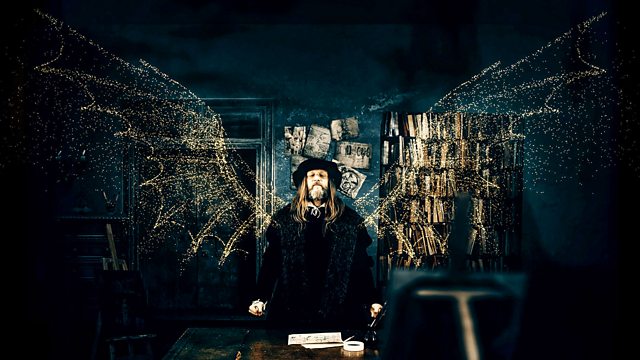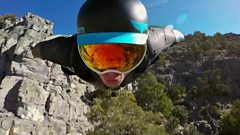
Planes
The amazing story of our greatest superpower - the ability to fly. A tale of passion, danger and death, it involves a bicycle, a toy, a disaster at sea and the ultimate sacrifice.
The aeroplane gave us a great superpower - the ability to fly. But how we got it is a story full of passion, danger and death. We start with a Moorish scholar jumping off a cliff 11 centuries ago, with feathers on his arms. A modern wing-suit flyer illustrates the feat.
The key to flight is to master the air. That starts even earlier with the Chinese, who invent the kite. It proves that a heavier-than-air object can fly by producing lift. Enter Leonardo da Vinci, who deduces that humans are unlikely to be able to generate the forces required to fly like a bird. So, he imagines a machine flapping its wings. Unfortunately, he never gets one to work. To find out why requires modern analysis. At MIT in California, scientists explain that we now know that the flapping of wings is only one part of flight.
It would take an obscure British nobleman to unpick the puzzle. Sir George Cayley lives near the sea in England. He wonders how seagulls glide without flapping their wings. He discovers how lift depends on the angle at which a wing is set, and not on flapping. Then, with the invention of the rubber band, Frenchman Alphonse Penaud spots its potential to drive a propeller. In 1871, he designs a remarkable toy that looks just like a modern aircraft. Next, he designs a full-size machine decades ahead of its time. Sadly, Penaud cannot fund his idea. Aged just 30, he kills himself. But Penaud鈥檚 legacy endures. In Iowa, a man buys a toy based on Penaud鈥檚 design for his two sons, Wilbur and Orville.
Meanwhile, in Germany, a young entrepreneur has begun his own experiments. Otto Lilienthal is also obsessed with gliding birds and builds his own glider. However, he crashes and dies. On hearing of Otto鈥檚 death, Wilbur and Orville Wright determine to solve the problem of flight for themselves. Inspired by the flexibility of a thin box for the inner tube of a bicycle, they invent a method for twisting the wings of a plane to maintain control. In 1902, they begin tests at Kitty Hawk. We recreate the flights using an exact replica. A year later, the brothers return with a powered aircraft using a lightweight gasoline motor, possible because of the recent boom in automobiles.
The modern aeroplane becomes a reality and, driven by the needs of World War I, progress is rapid. But now a major danger is losing orientation in cloud or fog. The answer to that lies in a machine that is already obsolete, mighty iron ship the SS Great Britain. Unfortunately, the iron hull interferes with her compass, leading her to run aground. The solution is the invention of the gyrocompass, which, when adapted in the late 1920s for use in aircraft, allows planes to fly in almost any weather. Now commercial aviation can begin, but it is still low, slow and dangerous.
In 1929, a plane crashes into Mt Taylor in Arizona, becoming the first airline disaster. A better way is needed. One man thinks the answer is higher and faster. Wiley Post is a record-breaking pioneer aviator of the 1930s. He knows that to go faster he will have to fly higher, where the air is thin and there is less bad weather. But he also knows that altitude is dangerous. Inspired by a diving suit, he creates the world鈥檚 first pressure suit, the forerunner of the space suit.
Post鈥檚 experiments show the advantages of high-altitude flight, and the modern, pressurised, high-altitude plane swiftly follows. However, propeller engines are not well suited to thin air either. The solution had already been worked out by a 21-year-old student in 1921. The problem had been finding someone to pay for it. Frank Whittle knew that a better method of propulsion would be to compress high-altitude air until it was thicker, burn fuel in this air and use the expanding gas to shoot itself backwards in a jet. This would produce a forward force at any altitude. We demonstrate the advantage this engine has using a modern-day Iron Man jet-suit. Funding is eventually found, and the jet age begins. Without any one of these revolutionaries, we might never have left the ground.
Last on
More episodes
Previous
You are at the first episode
Next
See all episodes from Revolutions: The Ideas that Changed the World
Clip
-
![]()
What enables humans to fly?
Duration: 02:42
Credits
| Role | Contributor |
|---|---|
| Presenter | Jim Al-Khalili |
| Interviewed Guest | Brandon Mikesell |
| Interviewed Guest | Shini Somara |
| Interviewed Guest | David Lentink |
| Interviewed Guest | Tiera Guinn Fletcher |
| Interviewed Guest | Bruce Weaver |
| Interviewed Guest | Richard Browning |
| Executive Producer | Iain Riddick |
| Executive Producer | Ben Bowie |
| Director | Stephen Mizelas |
| Director | Nathan Williams |
Broadcast
- Tue 23 Jul 2019 21:00

